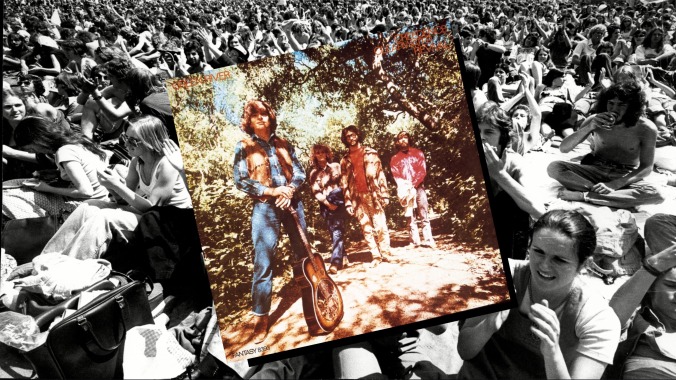Time Capsule: Creedence Clearwater Revival, Green River
Subscriber Exclusive

Every Saturday, Paste will be revisiting albums that came out before the magazine was founded in July 2002 and assessing its current cultural relevance. This week, we’re looking at Creedence Clearwater Revival’s third album, a 29-minute affair that jump-started their reign on rock ‘n’ roll in the Western world for the next three years through tapestries of muscular, catchy swamp tracks.
Who is the greatest American rock band ever? It’s a question that, as all great debates must, rages on far into modern discourse. Typical answers involve the Beach Boys, the Grateful Dead and Nirvana, maybe Eagles sneak in there or Aerosmith, the Doors and Metallica upset the competition. If we’re talking about influence, it very well might be the Velvet Underground or the Ramones. But it’s hard to carry on those conversations while omitting a very easy choice: Creedence Clearwater Revival. Though the band was founded by John Fogerty, Doug Clifford and Stu Cook as the Blue Velvets at Portola Junior High School in El Cerrito in 1959, the group we recognize now didn’t exist for almost another decade, after Fogerty’s crew hitched their wagon to Fantasy Records and went by Vision and, later, the Golliwogs before settling on Creedence Clearwater Revival in 1967.
In those early days, the Blue Velvets played instrumentals and jukebox standards, recording three singles and getting radio play from Casey Kasem’s KEWB radio channel in Oakland. After Fogerty and Clifford were drafted in the military during Vietnam, Fogerty became the band’s de facto frontman—playing lead guitar, saxophone, harmonica, keyboards and singing lead vocals. The first CCR single, “Porterville,” didn’t chart anywhere, but it would wind up on an eponymous debut album that spawned two Hot 100-charting songs in 1968: “Suzie Q” and “I Put a Spell on You,” the former of which peaked at #11 and has since been certified Platinum. But few groups in North America, or across the globe, have had a peak like the one Creedence Clearwater Revival had from 1969 to 1971.
It started with Bayou Country in January 1969, of course, which features “Born on the Bayou,” a Gold-certified single that didn’t chart, and “Proud Mary,” the song that went to #2 on the Hot 100 (and charted in 12 countries), got certified Platinum twice and is, undoubtedly, one of the most recognizable CCR songs ever—if not the most recognizable. But Bayou Country, despite it reaching the Top 10 on the Billboard 200, was an uneven affair. Aside from the two aforementioned singles, much of the seven-song tracklist is forgettable—save for a cover of Little Richard’s “Good Golly, Miss Molly” and the beautifully-named “Keep on Chooglin’.” It was a great way to kick off the year, though, and Fogerty and the guys would return in August with another album: Green River.
There is no definitive “greatest” Creedence Clearwater Revival album, though Cosmo’s Factory in 1970 is a perfect album. But Cosmo’s Factory’s Achilles heel is that it’s a plateau of swamp rock goodness. The songs are all so level with themselves that the record’s highs aren’t nearly as remarkable as the highs elsewhere in CCR’s catalog. That is why my needle always points in the direction of Green River, a 29-minute outing with four of the band’s greatest successes ever—songs so undeniably good that, even if the other five tracks were awful, the album would still be a resoundingly enjoyable affair. But the other five songs on Green River are pretty good, too.
Creedence Clearwater Revival recorded Green River at Wally Heider in San Francisco from March to June 1969. Like Bayou Country, John Fogerty produced the entire album himself. Clifford would recall that what set the band apart from their contemporaries was their focus. “We went to see the local bands and they were so stoned they weren’t even in tune and they were really terrible,” he said. “We made a pact on the floor of the Fillmore, right then, where we would do no drugs or alcohol. We decided to get high on the music, or get out of the business.”
With that context, the band’s swamp rock sound makes too much sense. Their heaviness never once flirted with the tripped-out trends embraced by their peers, like Jefferson Airplane and the Mothers of Invention. Rather than lean into the acid rock that would define an event like Woodstock, which occurred a week after Green River’s release and featured the band on the bill, CCR bought into their own rockabilly and blues roots. CCR were allergic to the idea of jam music, opting to get in and get out. “I didn’t like the idea of those 45-minute guitar solos. I thought music should get to the point a little more quickly than that,” Fogerty once said.
-

-

-

-

-

-

-

-

-

-

-

-

-

-

-

-

-

-

-

-

-

-

-

-

-

-

-

-

-

-

-

-

-

-

-

-

-

-

-

-








































